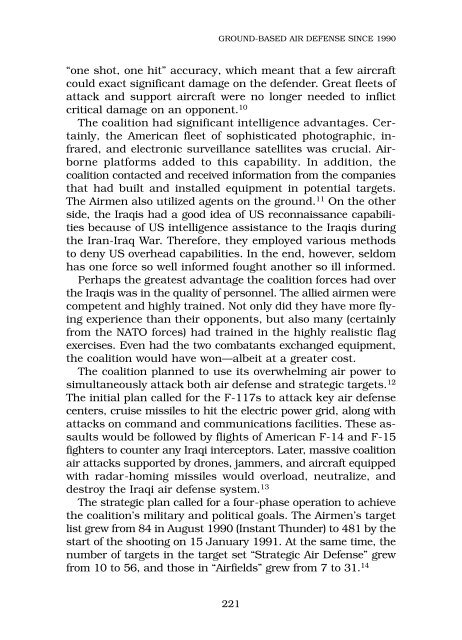Archie to SAM: A Short Operational History of Ground-Based Air ...
Archie to SAM: A Short Operational History of Ground-Based Air ...
Archie to SAM: A Short Operational History of Ground-Based Air ...
You also want an ePaper? Increase the reach of your titles
YUMPU automatically turns print PDFs into web optimized ePapers that Google loves.
GROUND-BASED AIR DEFENSE SINCE 1990<br />
“one shot, one hit” accuracy, which meant that a few aircraft<br />
could exact significant damage on the defender. Great fleets <strong>of</strong><br />
attack and support aircraft were no longer needed <strong>to</strong> inflict<br />
critical damage on an opponent. 10<br />
The coalition had significant intelligence advantages. Certainly,<br />
the American fleet <strong>of</strong> sophisticated pho<strong>to</strong>graphic, infrared,<br />
and electronic surveillance satellites was crucial. <strong>Air</strong>borne<br />
platforms added <strong>to</strong> this capability. In addition, the<br />
coalition contacted and received information from the companies<br />
that had built and installed equipment in potential targets.<br />
The <strong>Air</strong>men also utilized agents on the ground. 11 On the other<br />
side, the Iraqis had a good idea <strong>of</strong> US reconnaissance capabilities<br />
because <strong>of</strong> US intelligence assistance <strong>to</strong> the Iraqis during<br />
the Iran-Iraq War. Therefore, they employed various methods<br />
<strong>to</strong> deny US overhead capabilities. In the end, however, seldom<br />
has one force so well informed fought another so ill informed.<br />
Perhaps the greatest advantage the coalition forces had over<br />
the Iraqis was in the quality <strong>of</strong> personnel. The allied airmen were<br />
competent and highly trained. Not only did they have more flying<br />
experience than their opponents, but also many (certainly<br />
from the NATO forces) had trained in the highly realistic flag<br />
exercises. Even had the two combatants exchanged equipment,<br />
the coalition would have won—albeit at a greater cost.<br />
The coalition planned <strong>to</strong> use its overwhelming air power <strong>to</strong><br />
simultaneously attack both air defense and strategic targets. 12<br />
The initial plan called for the F-117s <strong>to</strong> attack key air defense<br />
centers, cruise missiles <strong>to</strong> hit the electric power grid, along with<br />
attacks on command and communications facilities. These assaults<br />
would be followed by flights <strong>of</strong> American F-14 and F-15<br />
fighters <strong>to</strong> counter any Iraqi intercep<strong>to</strong>rs. Later, massive coalition<br />
air attacks supported by drones, jammers, and aircraft equipped<br />
with radar-homing missiles would overload, neutralize, and<br />
destroy the Iraqi air defense system. 13<br />
The strategic plan called for a four-phase operation <strong>to</strong> achieve<br />
the coalition’s military and political goals. The <strong>Air</strong>men’s target<br />
list grew from 84 in August 1990 (Instant Thunder) <strong>to</strong> 481 by the<br />
start <strong>of</strong> the shooting on 15 January 1991. At the same time, the<br />
number <strong>of</strong> targets in the target set “Strategic <strong>Air</strong> Defense” grew<br />
from 10 <strong>to</strong> 56, and those in “<strong>Air</strong>fields” grew from 7 <strong>to</strong> 31. 14<br />
221
















